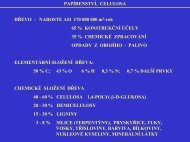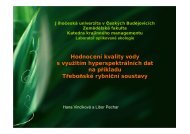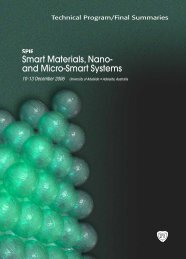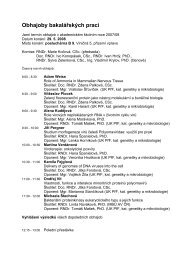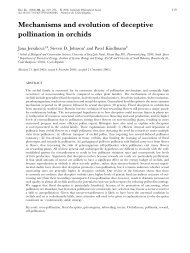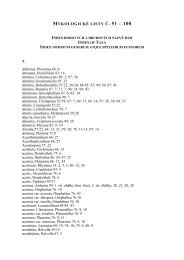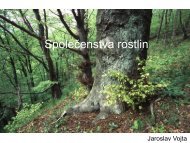Importance of species traits for species distribut... - ResearchGate
Importance of species traits for species distribut... - ResearchGate
Importance of species traits for species distribut... - ResearchGate
You also want an ePaper? Increase the reach of your titles
YUMPU automatically turns print PDFs into web optimized ePapers that Google loves.
Ecology, 88(4), 2007, pp. 965–977Ó 2007 by the Ecological Society <strong>of</strong> AmericaIMPORTANCE OF SPECIES TRAITS FOR SPECIES DISTRIBUTIONIN FRAGMENTED LANDSCAPESKATEŘINA TREMLOVA´1 AND ZUZANA MU¨ NZBERGOVA´1,2,31 Department <strong>of</strong> Botany, Faculty <strong>of</strong> Science, Charles University, Bena´tska´ 2, CZ-128 01 Praha 2, Czech Republic2 Institute <strong>of</strong> Botany, Academy <strong>of</strong> Sciences <strong>of</strong> the Czech Republic, Za´mek 1, CZ-252 43 Pru˚honice, Czech RepublicAbstract. Knowledge <strong>of</strong> the relationship between <strong>species</strong> <strong>traits</strong> and <strong>species</strong> <strong>distribut</strong>ion infragmented landscapes is important <strong>for</strong> understanding current <strong>distribut</strong>ion patterns and asbackground in<strong>for</strong>mation <strong>for</strong> predictive models <strong>of</strong> the effect <strong>of</strong> future landscape changes. Theexisting studies on the topic suffer from several drawbacks. First, they usually consider only<strong>traits</strong> related to dispersal ability and not growth. Furthermore, they do not apply phylogeneticcorrections, and we thus do not know how considerations <strong>of</strong> phylogenetic relationships canalter the conclusions. Finally, they usually apply only one technique to calculate habitatisolation, and we do not know how other isolation measures would change the results.We studied the issues using 30 <strong>species</strong> <strong>for</strong>ming congeneric pairs occurring in fragmenteddry grasslands. We measured <strong>traits</strong> related to dispersal, survival, and growth in the <strong>species</strong> andrecorded <strong>distribut</strong>ion <strong>of</strong> the <strong>species</strong> in 215 grassland fragments.We show many strong relationships between <strong>species</strong> <strong>traits</strong> related to both dispersal andgrowth and <strong>species</strong> <strong>distribut</strong>ion in the landscape, such as the positive relationship betweenhabitat occupancy and anemochory and negative relationships between habitat occupancyand seed dormancy. The directions <strong>of</strong> these relationships, however, <strong>of</strong>ten change afterapplication <strong>of</strong> phylogenetic correction. For example, more isolated habitats host <strong>species</strong> withsmaller seeds. After phylogenetic correction, however, they turn out to host <strong>species</strong> with largerseeds.The conclusions also partly change depending on how we calculate habitat isolation.Specifically, habitat isolation calculated from occupied habitats only has the highest predictivepower. This indicates slow dynamics <strong>of</strong> the <strong>species</strong>.All the results support the expectation that <strong>species</strong> <strong>traits</strong> have a high potential to explainpatterns <strong>of</strong> <strong>species</strong> <strong>distribut</strong>ion in the landscape and that they can be used to build predictivemodels <strong>of</strong> <strong>species</strong> <strong>distribut</strong>ion. The specific conclusions are, however, dependent on thetechnique used, and we should carefully consider this when comparing among differentstudies. Since different techniques answer slightly different questions, we should attempt to useanalyses both with and without phylogenetic correction and explore different isolationmeasures whenever possible and compare the results.Key words: endozoochory; exozoochory; growth rate; habitat occupancy; habitat suitability; lifehistory; metapopulation; phylogenetic contrast; seed bank; seed dispersal; seed size; terminal velocity.INTRODUCTIONHabitat fragmentation is considered to be one <strong>of</strong> themajor threats to biodiversity (Eriksson and Ehrle´n 2001,Oostermeijer et al. 2003). Recent studies on patterns <strong>of</strong><strong>distribut</strong>ion in fragmented landscapes have shown that alarge number <strong>of</strong> habitats suitable <strong>for</strong> a given <strong>species</strong> stayunoccupied by this <strong>species</strong> (e.g., Eriksson and Ehrle´n1992, van der Meijden et al. 1992, Ackerman et al. 1996,Eriksson 1996, Ehrle´n and Eriksson 2000, Mu¨nzbergova´2004). These results imply that <strong>distribut</strong>ion <strong>of</strong> <strong>species</strong> insuch landscapes is largely limited by <strong>species</strong> ability tospread among localities and successfully establish.Manuscript received 12 June 2006; revised 11 October 2006;accepted 18 October 2006. Corresponding Editor: T. J.Stohlgren.3Corresponding author. E-mail: zuzmun@natur.cuni.cz965This phenomenon <strong>of</strong> absence <strong>of</strong> <strong>species</strong> from suitablehabitats has stimulated studies in which <strong>species</strong> <strong>traits</strong>(mainly related to dispersal ability) are related to thepatterns <strong>of</strong> <strong>distribut</strong>ion <strong>of</strong> <strong>species</strong> in fragmentedlandscapes (Matlack 2005). Knowledge <strong>of</strong> such <strong>traits</strong>can help understanding current <strong>distribut</strong>ion patterns. Itcan also serve as background in<strong>for</strong>mation <strong>for</strong> predictivemodels allowing quantification <strong>of</strong> the effect <strong>of</strong> futurelandscape changes on <strong>species</strong> <strong>distribut</strong>ions (e.g., Higginset al. 2003, Mu¨nzbergova´ et al. 2005, Trakhtenbrot et al.2005). The relationship between <strong>species</strong> <strong>traits</strong>, landscapeattributes (<strong>distribut</strong>ion and sizes <strong>of</strong> localities) and<strong>species</strong> <strong>distribut</strong>ion has thus been a topic <strong>of</strong> manyrecent studies (e.g., Bastin and Thomas 1999, Dupre´ andEhrle´n 2002, Maurer et al. 2003, Kolb and Diekmann2005). The existing studies on these relationships,however, suffer from several drawbacks.
966 KATEŘINA TREMLOVÁ AND ZUZANA MU¨ NZBERGOVÁ Ecology, Vol. 88, No. 4PLATE 1.Dry grasslands represent the most <strong>species</strong>-rich communities in the region. Photo credit: David Pu¨schel.First, most <strong>of</strong> the studies do not take into accountphylogenetic relationships between <strong>species</strong> (e.g., Ouborg1993, Quintana-Ascentio and Menges 1996, Hanski1999, Kolb and Diekmann 2005; but see Maurer et al.2003). While such analyses are useful and providevaluable insights into general <strong>traits</strong> determining <strong>species</strong><strong>distribut</strong>ion in a landscape, without phylogenetic control,we cannot be sure whether presence <strong>of</strong> a <strong>species</strong> at alocality is related to the trait under study or to other<strong>traits</strong> correlated with these that are characteristic <strong>for</strong> thewhole clade to which the <strong>species</strong> belongs (Westoby et al.1995a, b).Distinguishing between the <strong>traits</strong> that are reallyresponsible <strong>for</strong> a pattern and <strong>traits</strong> correlated with thesewithin larger <strong>species</strong> groups can be achieved bycomparing results <strong>of</strong> analyses with and without phylogeneticcorrection. The necessity <strong>of</strong> such phylogeneticcorrection has been a highly debated issue (e.g., Harveyet al. 1995, Westoby et al. 1995a, b, Silvertown andDodd 1996, Freckleton et al. 2002, Pocock et al. 2006)and many authors have suggested that the phylogeneticaland ecological explanations <strong>for</strong> <strong>species</strong> <strong>distribut</strong>ionin a landscape are not mutually exclusive (see also Grimeand Hodgson 1987). Separating the different causes <strong>for</strong><strong>species</strong> <strong>distribut</strong>ion is thus relatively difficult. Still it isgenerally recognized that both <strong>of</strong> these types <strong>of</strong> analysesshould be considered when trying to explain the effect <strong>of</strong><strong>species</strong> <strong>traits</strong> on <strong>species</strong> <strong>distribut</strong>ion (e.g., Eriksson andJakobsson 1998, Freckleton et al. 2002, Reich et al.2003).The second issue is related to our perception <strong>of</strong> thelandscape and to ways <strong>of</strong> calculating isolation <strong>of</strong> thelocalities. While a lot <strong>of</strong> discussion has been devoted tothe algorithms <strong>of</strong> measuring habitat isolation/connectivity(Tischendorf and Fahring 2000), much less ef<strong>for</strong>thas been devoted to consideration <strong>of</strong> what localities toinclude in the measure. There are two principal ways tocalculate isolation: (1) only from occupied localities and(2) from all localities <strong>of</strong> the given type (subjectively or byexternal criteria classified as suitable). Bastin andThomas (1999) demonstrated that these different ways<strong>of</strong> calculating habitat isolation might affect conclusionson effects <strong>of</strong> isolation. These different ways to estimateisolation correspond to different perceptions <strong>of</strong> thelandscape. Using only occupied localities to defineisolation is based on a perception <strong>of</strong> the landscape asstatic, and assumes that <strong>distribut</strong>ion <strong>of</strong> the <strong>species</strong> hasnot changed much in the past. In the other approach,landscapes are viewed as more dynamic, where potential<strong>distribut</strong>ion is more important than current <strong>distribut</strong>ion,which is likely to change over time.The last issue we address in this paper is related to the<strong>species</strong> <strong>traits</strong> considered. It is relatively common toconsider <strong>traits</strong> related to <strong>species</strong> dispersal such as seedmass, terminal velocity, seed production or seed bank(e.g., Jackel and Poschlod 2000, Soons and Heil 2002),or simple growth-related <strong>traits</strong> such as plant height,flowering time, or life history strategy (e.g., Dupre´ andEhrle´n 2002, Maurer et al. 2003). The effect <strong>of</strong> <strong>traits</strong>related to plant growth is, however, largely unknown. Inspite <strong>of</strong> this, <strong>traits</strong> related to plant growth may be veryimportant <strong>for</strong> <strong>species</strong> ability to spread in newly occupiedlocalities and survive there since establishment andsurvival are important parts <strong>of</strong> colonization process(Eriksson and Jakobsson 1998).
April 2007 SPECIES TRAITS IN FRAGMENTED LANDSCAPES967FIG. 1.Distribution <strong>of</strong> the studied dry grasslands in the landscape.In this study, we take into account all the abovementionedissues and ask the following questions: (1)What is the effect <strong>of</strong> dispersal and growth related <strong>traits</strong><strong>for</strong> current <strong>species</strong> <strong>distribut</strong>ion in a landscape? (2) Howdo the conclusions <strong>of</strong> the study change when applyingphylogenetic correction? (3) How do the conclusionsdepend on the way <strong>of</strong> defining habitat isolation?To address these questions, we selected 30 <strong>species</strong><strong>for</strong>ming pairs <strong>of</strong> congeneric <strong>species</strong> occurring infragmented dry grasslands, a habitat not usuallyconsidered in studies <strong>of</strong> this type. We measured <strong>traits</strong>related to dispersal, individual survival and growth inthe <strong>species</strong> and recorded <strong>distribut</strong>ion <strong>of</strong> the <strong>species</strong> in215 grassland fragments.METHODSStudy area and <strong>species</strong>This study was carried out in northern Bohemia,Czech Republic. The study area is delimited by the LabeRiver on the south and by the villages <strong>of</strong> Sˇtětí, Krˇesˇice uLitomeˇrˇic, and Tuhanˇ aU´ sˇteˇk. In this region, calcareousdry grasslands <strong>for</strong>m distinct localities surroundedmainly by agricultural fields (see Plate 1). A total <strong>of</strong>215 dry grasslands were mapped representing all drygrassland localities within a region <strong>of</strong> approximately 40km 2 (Fig. 1). A locality is defined as a continuousgrassland with visually homogenous vegetation separatedfrom other localities by an unsuitable area. In cases <strong>of</strong>abrupt vegetation change within continuous grassland,the parts with different vegetation were treated asdifferent localities. These cases were not common; inall <strong>of</strong> them there was a visual topographic barrierbetween the localities such as a small ditch or change <strong>of</strong>slope from very steep to flat.We selected 30 native perennial herbs that wererestricted to dry calcareous grasslands in the studyregion and that are neither very rare nor extremelycommon in these localities. The <strong>species</strong> were alsoselected to <strong>for</strong>m 15 pairs <strong>of</strong> closely related <strong>species</strong>(Table 1). While most pairs consisted <strong>of</strong> <strong>species</strong> <strong>of</strong> thesame genus, in four cases, the pairs consisted <strong>of</strong>relatively closely related <strong>species</strong> from the same family(Table 1). To explore the effect <strong>of</strong> these four moredistantly related <strong>species</strong> pairs on the conclusions, wecarried all analyses both with and without them.Species <strong>traits</strong>We measured two types <strong>of</strong> <strong>traits</strong>: <strong>traits</strong> related to<strong>species</strong> dispersal ability and <strong>traits</strong> related to <strong>species</strong>survival and growth. They were terminal velocity, plantheight, ability to attach to sheep fur (exozoochory), seedmass, seed production, seed germination, proportion <strong>of</strong>viable seeds, seed dormancy, ability to flower in the firstyear (early flowering), production <strong>of</strong> aboveground and
968 KATEŘINA TREMLOVÁ AND ZUZANA MU¨ NZBERGOVÁ Ecology, Vol. 88, No. 4belowground biomass within one field season, andsurvival in the seed bank.Terminal velocity was estimated by measuring theflight time <strong>of</strong> a seed from a predefined height (3 m;Mu¨nzbergova´ 2004). Ten seeds from each <strong>of</strong> threedifferent populations <strong>of</strong> each <strong>species</strong> were measured.The type <strong>of</strong> propagule used <strong>for</strong> the measurementscorresponded to the propagule leaving the plant. Meandispersal distance (D, referred to as anemochory) wasexpressed asD ¼ðw 3 hÞ=tð1Þwhere w is the wind speed, h is the plant height, and t isthe terminal velocity. The wind speed used <strong>for</strong> thecalculation was a maximum daily mean wind speeddetected at a nearby meteorological station (Doksany)between 1993 and 2003 (13.7 m/s). This value wasselected just to illustrate the possible consequences <strong>of</strong> theterminal velocity and plant height <strong>for</strong> seed dispersal.Since wind speed is a constant in the calculation, usingother values would not affect the results. Plant heightwas estimated by measuring the height <strong>of</strong> 10 randomlyselected flowering plants per locality at each <strong>of</strong> threeselected localities.We are aware that our dispersal model is verysimplified. Nevertheless, it has been successfully usedin other studies to characterize mean dispersal distance<strong>of</strong> seeds (e.g., Soons and Heil 2002, Mu¨nzbergová et al.2005, Herben et al. 2006) and is the easiest way tocombine the three key parameters affecting dispersal.We thus suggest that it is a useful proxy <strong>of</strong> potentialwind dispersal distances <strong>for</strong> comparison among the<strong>species</strong>.Ability to disperse via exozoochory was assessed bygently placing a piece <strong>of</strong> sheep fur over a tray containing100 seeds, removing it and counting the number <strong>of</strong>attached seeds (Mu¨nzbergova´ 2004).Seed mass was estimated by weighing five groups <strong>of</strong> 10seeds from three source populations. It is generallyrecognized that seed mass can serve as proxy <strong>of</strong> seeddispersal ability and germination as well as competitiveability <strong>of</strong> the <strong>species</strong>.Seed production was estimated as number <strong>of</strong> floweringplants per square meter counted in 10 quadrats ineach <strong>of</strong> three populations <strong>of</strong> the <strong>species</strong>. The quadratswere intentionally selected in areas with the highestdensity <strong>of</strong> the <strong>species</strong> that could be found in the differentpopulations. This number was multiplied by seedproduction per plant estimated in these populations.This value was then multiplied by the proportion <strong>of</strong>viable seeds to estimate number <strong>of</strong> viable seeds producedper area per year. This value provides in<strong>for</strong>mation onmaximum seed production by a stand <strong>of</strong> a given <strong>species</strong>.It thus provides an estimate <strong>of</strong> the potential supply <strong>of</strong>seeds ready to colonize other localities.Traits related to plant growth were estimated in acommon garden experiment. In late summer (August toSeptember) 2003, 50 seeds <strong>of</strong> a single <strong>species</strong> were sownTABLE 1.List <strong>of</strong> <strong>species</strong> used in the study.Pairno.Species Abbreviation Family1 Agrimonia eupatoria Agr eup RosaceaeSanguisorba minor San min Rosaceae2 Asperula cynanchica Asp cyn RubiaceaeAsperula tinctoria Asp tin Rubiaceae3 Astragalus cicer Ast cic LeguminosaeAstragalus glycyphyllos Ast gly Leguminosae4 Brachypodium pinnatum Bra pin GramineaeBromus erectus Bro ere Gramineae5 Campanula glomerata Cam glo CampanulaceaeCampanula rotundifolia Cam rot Campanulaceae6 Carex tomentosa Car tom CyperaceaeCarex flacca Car fla Cyperaceae7 Centaurea jacea Cen jac CompositaeCentaurea scabiosa Cen sca Compositae8 Cirsium acaule Cir aca CompositaeCirsium pannonicum Cir pan Compositae9 Coronilla vaginalis Cor vag LeguminosaeCoronilla varia Cor var Leguminosae10 Inula hirta Inu hir CompositaeInula salicina Inu sal Compositae11 Laserpitium latifolium Las lat UmbelliferaePeucedanum cervaria Peu cer Umbelliferae12 Linum flavum Lin fla LinaceaeLinum tenuifolium Lin ten Linaceae13 Lotus corniculatus Lot cor LeguminosaeMedicago falcata Med fal Leguminosae14 Salvia pratensis Sal pra LabiataeSalvia verticillata Sal ver Labiatae15 Trifolium medium Tri med LeguminosaeTrifolium montanum Tri mon LeguminosaeNote: The nomenclature follows Tutin et al. (1964–1983).in 19 3 19 3 19 cm pots in a common garden in a 1:2mixture <strong>of</strong> sand and garden substrate. For each <strong>species</strong>,seeds originating from three different localities wereused. Seeds from one locality were placed into one pot;there were three replicates per locality and <strong>species</strong> thusyielding nine pots per <strong>species</strong>.In November 2003, we recorded the number <strong>of</strong>germinated seedlings per pot. Since the <strong>species</strong> eithergerminated at a high rate in the autumn or did notgerminate at all, we coded this in<strong>for</strong>mation as a binaryvariable (dormancy; yes or no). The ability to germinateearly indicates that the seeds do not posses any type <strong>of</strong>dormancy. For determining seed dormancy, it isimportant that the seeds be sown shortly after beingharvested. This in<strong>for</strong>mation provides an indication <strong>of</strong>the germination dynamics <strong>of</strong> the <strong>species</strong> and thus aboutthe potential per<strong>for</strong>mance <strong>of</strong> the seedlings at thelocalities.The number <strong>of</strong> plants in the pot was also recorded inMay 2004 <strong>for</strong> all <strong>species</strong> to have the same recording date<strong>for</strong> <strong>species</strong> with and without seed dormancy. For theearly germinating <strong>species</strong>, the May germination was thenumber <strong>of</strong> germinated plants in autumn reduced bywinter mortality. This number served as an estimate <strong>of</strong>germination fraction (germination in Petri dishes wasused only to estimate production <strong>of</strong> viable seeds perarea).
April 2007 SPECIES TRAITS IN FRAGMENTED LANDSCAPES969TABLE 2.List <strong>of</strong> <strong>traits</strong> used in the study.ParameterUnitsSeed massmgTerminal velocity m/sAnemochorymean dispersal distance (m)Seed production viable seeds/m 2Seed bank 100 (percentage decline ingermination ability after 1 yr)Exozoochory seeds attached to sheep fur (%)Germination fractionà plants after 1 yr from sown seeds(%)Dormancy ,à0/1 (germination in autumn/spring)Early flowering ,à 1/0 (flowering in the first year)Aboveground biomass ,à g (<strong>for</strong> one plant after 1 yr)These parameters were used in the test presented in thisstudy.à These parameters come from the common garden experiment.In autumn (September–November) 2004, we recordedthe presence <strong>of</strong> flowering plants in the pots to assess theability <strong>of</strong> the <strong>species</strong> to flower in the first year (earlyflowering; yes or no). In November 2004, the plants wereharvested. Each harvested plant was divided into aboveandbelowground biomass, dried to constant mass, andweighed. We used the mass <strong>of</strong> the largest plant per<strong>species</strong> as an estimate <strong>of</strong> growth ability <strong>of</strong> the <strong>species</strong>; inall cases there were one to three large plants in the potand sometimes also many small ones. We suggest thatthe size <strong>of</strong> the largest plant provides a relatively goodestimate <strong>of</strong> what a plant can do in natural conditionswithin one year. This indicates that the flowering canalso be interpreted as the ability <strong>of</strong> the <strong>species</strong> to do so,since at least some plants did not suffer from highcompetition. The division <strong>of</strong> the <strong>species</strong> into early andlate flowering categories, and biomass production <strong>of</strong> theplant, correspond well with our personal observationson per<strong>for</strong>mance <strong>of</strong> the plants in the field. We thussuggest these data can provide insights into growthdynamics <strong>of</strong> the plants in the field.To estimate the ability to survive in the seed bank,three nylon bags per <strong>species</strong>, each containing 50 seeds,were buried at each <strong>of</strong> two different localities inNovember 2003 and excavated in October 2004. Theexcavated seeds were tested <strong>for</strong> viability. The seeds wereregularly watered with distilled water on the Petri dishesand kept in a growth chamber under a fluctuatingregime (12 hours light at 208C, 12 hours dark at 108C).Germinated seeds were regularly removed. The seeds <strong>of</strong><strong>species</strong> that did not germinate were stimulated by addinggiberelic acid and abraded by sandpaper. The seeds thatstill did not germinate and did not decay were thentested <strong>for</strong> viability using the tetrazolium test. All seedsidentified as viable by any <strong>of</strong> the methods were summed.The same procedure was used to estimate the viability <strong>of</strong>fresh seeds (proportion <strong>of</strong> viable seeds) to provide abaseline from which to estimate the decline in germinationover time. The ability to <strong>for</strong>m a seed bank indicatesthat the seed can survive given that it does not havesuitable conditions <strong>for</strong> germination. It, however, doesnot imply it has any intrinsic dormancy.All measured <strong>traits</strong> are listed in Table 2 and values <strong>of</strong>these <strong>traits</strong> <strong>for</strong> each <strong>species</strong> are in Appendix A. In allcases, we were working with average values <strong>for</strong> each<strong>species</strong>.Habitat suitabilityTo calculate habitat occupancy and isolation <strong>of</strong> ahabitat, we had to define suitable localities. Suitablelocalities were defined using a Beals index (Beals 1984,Mu¨nzbergova´ and Herben 2004). This index calculatesthe probability <strong>of</strong> encountering a <strong>species</strong> at a localityusing data on the presence <strong>of</strong> other <strong>species</strong> at thatlocality and on patterns <strong>of</strong> co-occurrence <strong>of</strong> the target<strong>species</strong> with other <strong>species</strong>. To estimate the <strong>species</strong> cooccurrencepatterns, we used 2984 releve´s on <strong>species</strong>composition <strong>of</strong> dry calcareous grasslands in the CzechRepublic from the Czech national phytosociologicaldatabase (Chytrý and Rafajova´ 2003). Unoccupiedlocalities with a Beals index reaching at least the 5%quantile <strong>of</strong> the Beals index <strong>of</strong> occupied localities wereconsidered suitable. Using 1% or 10% quantiles did notsignificantly affect the conclusions.We also used data on abiotic conditions <strong>of</strong> thelocalities (geology, potential direct solar radiation, andslope <strong>of</strong> the target localities) to assess habitat suitability.These gave very similar results to the Beals index, so weuse only the <strong>for</strong>mer in the study.Habitat isolationWe used three different approaches to calculatehabitat isolation in this study. First, we calculatedisolation <strong>of</strong> a locality using its distance from all drygrasslands, subjectively assumed to be suitable <strong>for</strong> all the<strong>species</strong>, in the study region. In this case, habitat isolation<strong>of</strong> a given locality was the same <strong>for</strong> all the <strong>species</strong>.Second, we calculated isolation only from all occupiedlocalities. In this and in the following case, habitatisolation <strong>of</strong> a single locality differed among <strong>species</strong>.Finally, we calculated isolation from all localitiesclassified as suitable <strong>for</strong> the <strong>species</strong> using the Bealsindex. See Introduction <strong>for</strong> the rationale behind calculatingisolation from unoccupied localities and Eq. 2 <strong>for</strong>the exact way to do this.Calculation <strong>of</strong> habitat isolation was based oncentroids <strong>of</strong> the localities, derived from a digital map<strong>of</strong> the localities provided by T. Chýlova´. Isolation <strong>of</strong> alocality was expressed as a mass <strong>of</strong> surroundinglocalities weighted by its distance to the target locality.Isolation <strong>of</strong> a locality was expressed as follows:I ij ¼ X h inP k =djk2 3 O k ; j 6¼ k ð2Þk¼1where I ij is isolation <strong>of</strong> locality j <strong>for</strong> <strong>species</strong> i, k are all thesurrounding localities within 1.8 km distance from thetarget locality, P k is a size <strong>of</strong> locality k in squarekilometers, d jk is distance between localities j and k in
970 KATEŘINA TREMLOVÁ AND ZUZANA MU¨ NZBERGOVÁ Ecology, Vol. 88, No. 4TABLE 3.Correlations among single <strong>traits</strong> used in the study.ParameterSeedmassAnemochorySeedproductionDormancyEarlyfloweringAbovegroundbiomassSeedbankExozoochoryWithout phylogenetic correctionSeed mass 0.135 0.127 0.073 0.066 0.233 0.118 0.104Anemochory 0.135 0.050 0.193 0.181 0.273 0.106 0.475Seed production 0.127 0.050 0.254 0.091 0.091 0.266 0.312Germination fraction 0.153 0.147 0.216 0.117 0.177 0.215 0.180 0.079Dormancy 0.073 0.193 0.254 0.391 0.258 0.103 0.248Early flowering 0.066 0.181 0.091 0.391 0.498 0.122 0.129Aboveground biomass 0.233 0.273 0.091 0.258 0.498 0.653 0.375Seed bank 0.118 0.106 0.266 0.103 0.122 0.653 0.500Exozoochory 0.104 0.475 0.312 0.248 0.129 0.375 0.500With phylogenetic correctionSeed mass 0.069 0.052 0.342 0.125 0.326 0.293 0.488Anemochory 0.069 0.066 0.174 0.056 0.050 0.205 0.199Seed production 0.052 0.066 0.317 0.142 0.257 0.413 0.057Germination fraction 0.312 0.144 0.133 0.428 0.405 0.068 0.149 0.134Dormancy 0.342 0.174 0.317 0.589 0.186 0.100 0.081Early flowering 0.125 0.056 0.142 0.589 0.286 0.159 0.006Aboveground biomass 0.326 0.050 0.257 0.186 0.286 0.390 0.571Seed bank 0.293 0.205 0.413 0.100 0.159 0.390 0.278Exozoochory 0.488 0.199 0.057 0.081 0.006 0.571 0.278Notes: Significant correlations (P , 0.05) are in boldface. No correction <strong>for</strong> multiple testing was used here.kilometers, and O k is a binary (0,1) variable codingoccupancy or suitability <strong>of</strong> a locality. When calculatingisolation from all localities, O k is always 1.Isolation <strong>of</strong> a locality was calculated only <strong>for</strong> 187localities out <strong>of</strong> 215. The other localities were excludedbecause there were unanalyzed localities within 1.8 km<strong>of</strong> these localities. The 1.8-km zone was selected as adistance over which habitat isolation was measured; thiswas the maximum distance that we were able to reliablycover by the field survey. Not all marginal localities hadto be excluded, however, since large areas <strong>of</strong> arable fieldssurrounded some <strong>of</strong> the localities. Only the 187 localitieswere used in all the subsequent analyses.Data analysisTo reduce the high dimensionality <strong>of</strong> the trait-by<strong>species</strong>matrix, we selected only a subset <strong>of</strong> <strong>traits</strong> thatwere expected to be most in<strong>for</strong>mative and not tooclosely correlated with other <strong>traits</strong> (Table 2). Correlation<strong>of</strong> the remaining <strong>species</strong> <strong>traits</strong> was studied using simplecorrelation analysis. The <strong>traits</strong> that changed values overseveral orders <strong>of</strong> magnitude (seed mass, seed production,aboveground biomass) were logarithmically trans<strong>for</strong>medbe<strong>for</strong>e the analysis. This analysis was thenrepeated after subtracting the mean trait value <strong>for</strong> each<strong>species</strong> pair from the trait value <strong>of</strong> each <strong>species</strong> in thatpair; this was done to explore correlation among <strong>traits</strong>after phylogenetic correction.Some <strong>traits</strong> used in the analysis were significantlycorrelated (Table 3), but we did not want to excludethose since they carry different biologically meaningfulin<strong>for</strong>mation. In all the subsequent analyses, we werethus using multiple partly correlated <strong>traits</strong>. This couldtheoretically bias our conclusions. To explore this, we inall cases compared a test with all the variables includedwith results <strong>of</strong> stepwise analysis.To visualize similarity between the different <strong>species</strong> intheir <strong>traits</strong> we used principal component analysis (PCA).The data on single <strong>species</strong> <strong>traits</strong> were treated as‘‘<strong>species</strong>,’’ and data on each <strong>species</strong> represented ‘‘samples.’’The analysis was centered and standardized by‘‘<strong>species</strong>’’; in this way all the <strong>traits</strong> were expressed in thesame, relative, units. For this as well as <strong>for</strong> subsequentanalyses, we used only <strong>traits</strong> marked in Table 2.Percentage <strong>of</strong> occupancy <strong>of</strong> the localities was expressedas the portion <strong>of</strong> all occupied localities eitherfrom all localities, or from all suitable localities. Toestimate the effect <strong>of</strong> plant <strong>traits</strong> on overall habitatoccupancy, we used generalized linear models (GLM),assuming binomial <strong>distribut</strong>ion <strong>of</strong> the dependent variable.Numbers <strong>of</strong> occupied and all available localitieswere used as bind dependent variables (the variableswere combined into one variable using command cbindin S-PLUS 2000 (MathS<strong>of</strong>t, Needham, Massachusetts,USA), the resulting variable carries in<strong>for</strong>mation onfrequency <strong>of</strong> an event), and all <strong>species</strong> <strong>traits</strong> were used asindependent variables. The same analysis was thenrepeated with pair code as another independent variable.To estimate the effect <strong>of</strong> <strong>species</strong> <strong>traits</strong> and landscapeproperties on <strong>species</strong> occurrence at a locality, we usedlogistic regression. Presence <strong>of</strong> each <strong>species</strong> in eachlocality was used as the dependent variable, and size andisolation <strong>of</strong> a locality, all <strong>species</strong> <strong>traits</strong>, and theinteraction <strong>of</strong> all <strong>species</strong> <strong>traits</strong> with habitat size andisolation were used as independent variables. In the text,however, we present only the results <strong>for</strong> the interactionterms <strong>of</strong> habitat isolation/size and <strong>species</strong> <strong>traits</strong>. Theresults <strong>of</strong> the main effects would actually be a more
April 2007 SPECIES TRAITS IN FRAGMENTED LANDSCAPES971FIG. 2. Relationship between individual <strong>species</strong> determined by principal component analysis (PCA) using trait data asdependent variables. Species with solid black symbols are from the family Leguminosae, <strong>species</strong> with solid gray symbols are fromthe family Compositae, and <strong>species</strong> with open symbols are from the other families (each <strong>of</strong> these pairs is from a different family).Species abbreviations are provided in Table 1.complicated approach to study the effect <strong>of</strong> <strong>traits</strong> onhabitat occupancy mentioned above.Analyses calculating isolation from all dry grasslandsin the region and from only occupied localities werebased on all the studied localities. In the analyses withisolation calculated from all suitable localities, we usedata only from suitable localities <strong>for</strong> each <strong>species</strong>.To visualize interactions <strong>of</strong> <strong>traits</strong> and landscapeproperties in a graphic <strong>for</strong>m, we plotted the <strong>traits</strong> <strong>for</strong><strong>species</strong> occurring in localities with a given propertyagainst the property. The <strong>species</strong> missing at each localitywere not visualized in these graphs. To visualize theresults after phylogenetic correction, we used <strong>species</strong><strong>traits</strong> after subtracting the mean <strong>of</strong> the trait value <strong>for</strong>each <strong>species</strong> pair from the trait value.All the above analyses are based on <strong>traits</strong> across all 30<strong>species</strong> and do not allow easy interpretation <strong>of</strong> the<strong>distribut</strong>ion <strong>of</strong> the single <strong>species</strong>. To show how single<strong>species</strong> respond to habitat size and isolation, weper<strong>for</strong>med a multivariate canonical correspondenceanalysis (CCA) using presence <strong>of</strong> all the <strong>species</strong> at thelocality (<strong>species</strong> composition based on the 30 <strong>species</strong>) asthe dependent variable and habitat size or isolation asindependent variables. To separate the effect <strong>of</strong> habitatsize and isolation, we also per<strong>for</strong>med analyses withhabitat size as an independent variable and isolation ascovariate and the other way round. The analyses weredone only <strong>for</strong> isolation from all localities, i.e., the type <strong>of</strong>isolation that is the same <strong>for</strong> all the <strong>species</strong>.All the univariate analyses were done using S-PLUS2000; all the multivariate analyses were done usingCANOCO (ter Braak and Sˇmilauer 1998). All theunivariate analyses were done with type III sum <strong>of</strong>squares, so the effect <strong>of</strong> each independent variable wasestimated after removing the effect <strong>of</strong> all the otherindependent variables.RESULTSCorrelation <strong>of</strong> the different <strong>traits</strong> shows a positiverelationship between anemochory and exozoochory.There is also a positive relationship between abovegroundbiomass <strong>of</strong> a plant in the first year and its abilityto flower in the first year and to produce a seed bank.Plants with high aboveground biomass tend to have lowability to disperse via exozoochory. There is also anegative relationship between ability to create seed bankand exozoochory and between seed dormancy andability to flower early (Table 3).Only three <strong>of</strong> these relationships stay significant afterphylogenetic correction (between aboveground biomassand seed bank and exozoochory and between earlyflowering and dormancy). There is also a significantpositive relationship between seed mass and exozoochoryand seed production and seed bank (Table 3). Thecorrelations partly change after removing the four noncongenericpairs (see Appendix B).Comparison <strong>of</strong> <strong>traits</strong> <strong>of</strong> <strong>species</strong> within the pairsindicates that many <strong>species</strong> within a pair are ratherdissimilar (Fig. 2). Nevertheless, <strong>species</strong> pair explains78% <strong>of</strong> the total variation in the dataset as identifiedusing PCA with <strong>species</strong> pair as a covariate.Tests exploring the effect <strong>of</strong> <strong>species</strong> <strong>traits</strong> on habitatoccupancy indicate many significant patterns (Table 4).When working with all localities and without phyloge-
April 2007 SPECIES TRAITS IN FRAGMENTED LANDSCAPES973Effects <strong>of</strong> interactions between habitat size/isolation and <strong>species</strong> <strong>traits</strong> on <strong>species</strong> occurrence at a locality estimated usinglogistic regression.TABLE 5.Without PCWith PCHabitat size Isolation Habitat size IsolationParametersP R 2 P R 2 P R 2 P R 2Occupied localitiesSeed mass 0.895 0.05 0.005 ( ) 0.384 0.01 0.002 (þ)Anemochory 0.622 ,0.001 0.006 ( ) 0.584 ,0.001 0.006 ( )Seed production 0.32 0.178 0.666 0.749Dormancy 0.337 0.001 0.002 (þ) 0.524 0.236Early flowering 0.049 0.001 ( ) ,0.001 0.003 (þ) 0.401 0.13Aboveground biomass 0.441 0.004 0.002 (þ) 0.978 ,0.001 0.002 ( )Seed bank 0.281 0.024 0.001 (þ) ,0.001 0.003 (þ) 0.022 0.002 (þ)Exozoochory 0.736 0.56 0.384 0.35All localitiesSeed mass 0.424 0.941 0.049 0.001 (þ) 0.854Anemochory 0.437 0.107 0.344 0.078 0.001 ( )Seed production 0.286 0.509 0.682 0.789Dormancy 0.228 0.456 0.405 0.601Early flowering 0.05 0.001 ( ) 0.733 0.445 0.558Aboveground biomass 0.341 0.117 0.995 0.114Seed bank 0.251 0.14 0.086 0.001 (þ) 0.065 0.001 (þ)Exozoochory 0.707 0.522 0.381 0.578Suitable localitiesSeed mass 0.446 0.776 0.049 0.001 (þ) 0.46Anemochory 0.244 0.001 0.002 (þ) 0.396 0.003 0.002 ( )Seed production 0.238 0.3 0.525 0.434Dormancy 0.829 0.508 0.71 0.796Early flowering 0.239 0.381 0.693 0.488Aboveground biomass 0.535 0.152 0.977 0.234Seed bank 0.228 0.092 0.086 0.047 0.001 (þ)Exozoochory 0.809 0.3 0.383 0.193Notes: The sign <strong>of</strong> the relationship is provided <strong>for</strong> significant results. Error df ¼ 3707 and 3692 <strong>for</strong> analyses using isolation fromall or occupied localities without and with phylogenetic correction (PC), respectively; error df ¼ 3274 and 3259 <strong>for</strong> analyses usingisolation from all suitable localities without and with phylogenetic correction, respectively.covariate did not change these results very much andthus are not shown. In more isolated localities, <strong>species</strong>such as Inula hirta, Campanula rotundifolia, Cirsiumacaule, Salvia pratensis, and Astragalus glycyphyllos aremore common. On the other hand, <strong>species</strong> such asLinum flavum, Laserpitium latifolium, Cirsium pannonicum,Coronilla vaginalisi, and Campanula glomerata aremore common in less isolated localities (see Table 6 <strong>for</strong>full list <strong>of</strong> <strong>species</strong>). Smaller localities host <strong>species</strong> such asCampanula glomerata, Laserpitium latifolium, Bromuserectus, and Cirsium pannonicum, while in largerlocalities Inula hirta, Linum tenuifolium, Campanularotundifolia, and Asperula tinctoria are more common(see Table 5 <strong>for</strong> a full list <strong>of</strong> <strong>species</strong>). These relationshipsdid not change much after removing the non-congenericpairs. The main difference was a lower percentage <strong>of</strong>variation explain by habitat size and isolation (notshown).DISCUSSIONResults <strong>of</strong> this study show a strong relationshipbetween <strong>species</strong> <strong>traits</strong> and <strong>species</strong> <strong>distribut</strong>ion in thelandscape. This is true both when looking at percentage<strong>of</strong> habitat occupancy and when looking at <strong>species</strong>response to habitat size and isolation. However, thespecific nature <strong>of</strong> the relationships <strong>of</strong>ten changes afterphylogenetic correction or with different definitions <strong>of</strong>habitat isolation.Exploration <strong>of</strong> <strong>species</strong> <strong>traits</strong> studied in this paperindicates many significant relationships between these.For example, we have demonstrated significant relationshipbetween the ability to disperse by anemochoryand exozoochory (see also Fischer et al. 1996). Ourresults, however, also indicate that this pattern disappearswhen per<strong>for</strong>ming phylogenetic correction. Similarly,we found a negative relationship between seeddispersal ability (exozoochory) and survival in the seedbank (see also Ehrle´n and Groenendael 1998). Again,this relationship disappeared after phylogenetic correction.The reversal <strong>of</strong> the relationships between <strong>species</strong><strong>traits</strong> after phylogenetic correction is in agreement withprevious studies (e.g., Silvertown and Dodd 1996) andsuggests that we should expect different conclusions inthe subsequent analyses with and without phylogeneticcorrection.Percentage <strong>of</strong> habitat occupancy was significantlyaffected by both <strong>traits</strong> related to seed dispersal and <strong>traits</strong>related to plant growth. A high number <strong>of</strong> <strong>species</strong> <strong>traits</strong>explaining habitat occupancy is in agreement withprevious studies exploring this relationship (e.g., Ouborg
974 KATEŘINA TREMLOVÁ AND ZUZANA MU¨ NZBERGOVÁ Ecology, Vol. 88, No. 4FIG. 3. Relationship between <strong>species</strong> <strong>traits</strong> and landscapeproperties: (A) anemochory and habitat isolation, (B) log(seedmass) and habitat isolation, and (C) log(seed mass) afterphylogenetic correction and habitat isolation. For the purpose<strong>of</strong> the graph, habitat isolation was divided into threeequidistant categories. In each case, only <strong>species</strong> occurring atthe given locality are included. All the patterns are significant(Table 5).1993, Eriksson and Jakobsson 1998, Maurer et al. 2003,Kolb and Diekmann 2005). In our study, more widely<strong>distribut</strong>ed <strong>species</strong> had better dispersal ability as well asfaster growth. Kolb and Diekmann (2005) found asimilar pattern <strong>for</strong> dispersal. On the other hand,Eriksson and Jakobsson (1998) and Maurer et al.(2003) have shown that habitat occupancy does notdepend on <strong>traits</strong> related to dispersal.Species <strong>traits</strong> also determine <strong>species</strong> response tohabitat size and isolation; with more significant interactionswith habitat isolation than with size. This is inagreement with conclusions <strong>of</strong> Piessens et al. (2004) andKolb and Diekmann (2005), who showed higher effects<strong>of</strong> habitat isolation than size on <strong>species</strong> occurrence in<strong>for</strong>est fragments. In all comparisons, we have shownthat <strong>species</strong> with higher anemochory are missing fromisolated localities. This contrasts with conclusions <strong>of</strong>Piessens et al. (2005), who suggested that anemochory isthe most important trait allowing <strong>species</strong> survival atisolated localities. The observed pattern clearly indicatesthat anemochory is not the main factor that canguarantee <strong>species</strong> occurrence in isolated localities. Alsowe did not find any significant effect <strong>of</strong> exozoochory.This may indicate that it is not dispersal but ratherestablishment that limits <strong>species</strong> <strong>distribut</strong>ion at isolatedhabitats. It is, however, also possible that other dispersal<strong>traits</strong> that were not measured in this study, such asendozoochory, are the most important dispersal types inthe studied landscape (e.g., Bonn 2004). Isolatedlocalities also host <strong>species</strong> with significantly smallerseeds suggesting that seed size might be better predictor<strong>of</strong> dispersal than our (assumed) more direct measures <strong>of</strong>dispersability (Ehrle´n and Eriksson 2000).In agreement with Piessens et al. (2004), we haveshown that survival in the seed bank is important <strong>for</strong><strong>species</strong> presence in isolated localities. This pattern is alsoin agreement with many other studies that indicate thatsurvival in seed bank is crucial <strong>for</strong> population survival(e.g., Thompson et al. 1998, Turnbull et al. 2000).The results also show that <strong>species</strong> occurring in smallerlocalities flower earlier than <strong>species</strong> in larger localities.This can be explained by the fact that small localitieshave a higher edge-to-area ratio and are thus moredisturbed. Disturbed localities have also been shown tohost early flowering <strong>species</strong> in previous studies (e.g.,Thompson and Rabonowitz 1989, Thompson andHodkinson 1998, Silvertown and Charlesworth 2001,Ehrle´n and Lehtilä 2002).An important conclusion from this study is that theeffect <strong>of</strong> <strong>species</strong> <strong>traits</strong> on <strong>species</strong> response to habitat sizeand isolation can completely reverse when applyingphylogenetic correction (reversals after phylogeneticcorrection were found also by Murray et al. [2002] andPocock et al. [2006] but not, e.g., by Maurer et al. [2003]and De Bello et al. [2005]). For example, <strong>species</strong> weredetected to have smaller seeds when occurring at moreisolated localities, but this relationship reversed directionafter phylogenetic correction (see also Eriksson andJakobsson 1998). The contradiction between the twopatterns is probably a consequence <strong>of</strong> the stability <strong>of</strong>seed size within <strong>species</strong> phylogenies (e.g., Mazer 1989,Kelly and Purvis 1993, Kelly 1995). The main effect <strong>of</strong>seed size was thus probably removed when per<strong>for</strong>ming
April 2007 SPECIES TRAITS IN FRAGMENTED LANDSCAPES975Response <strong>of</strong> studied <strong>species</strong> to habitat isolation and size determined using canonicalcorrespondence analysis (CCA).TABLE 6.Response to isolationResponse to habitat sizeSpecies Position Species PositionInula hirta 0.402 Campanula glomerata 0.6187Campanula rotundifolia 0.2091 Laserpitium latifolium 0.6081Cirsium acaule 0.1722 Bromus erectus 0.1377Salvia pratensis 0.1411 Cirsium pannonicum 0.127Astragalus glycyphyllos 0.1187 Linum flavum 0.0943Bromus erectus 0.1017 Sanguisorba minor 0.0753Carex tomentosa 0.0655 Brachypodium pinnatum 0.0681Trifolium medium 0.0629 Salvia verticillata 0.0597Asperula tinctoria 0.0604 Coronilla varia 0.0585Lotus corniculatus 0.0503 Centaurea jacea 0.0429Carex flacca 0.0404 Agrimonia eupatoria 0.0162Agrimonia eupatoria 0.0139 Asperula cynanchica 0.0024Centaurea scabiosa 0.0037 Trifolium montanum 0.0091Coronilla varia 0.0111 Lotus corniculatus 0.0094Brachypodium pinnatum 0.0215 Cirsium acaule 0.0142Medicago falcata 0.0276 Medicago falcata 0.016Sanguisorba minor 0.0384 Carex flacca 0.0305Trifolium montanum 0.0457 Trifolium medium 0.0382Centaurea jacea 0.0591 Coronilla vaginalis 0.0447Salvia verticillata 0.0601 Centaurea scabiosa 0.0562Linum tenuifolium 0.0664 Salvia pratensis 0.0612Inula salicina 0.1001 Inula salicina 0.0694Astragalus cicer 0.1112 Carex tomentosa 0.0737Asperula cynanchica 0.1184 Astragalus glycyphyllos 0.1182Peucedanum cervaria 0.3271 Astragalus cicer 0.1682Campanula glomerata 0.3499 Peucedanum cervaria 0.1968Coronilla vaginalis 0.363 Asperula tinctoria 0.2291Cirsium pannonicum 0.7953 Campanula rotundifolia 0.2575Laserpitium latifolium 0.8394 Linum tenuifolium 0.3596Linum flavum 1.0103 Inula hirta 0.6533Notes: Habitat isolation explained 9.02% <strong>of</strong> the variation in <strong>species</strong> composition that could beexplained by one ordination axis; the effect is significant. Habitat size explained 6.01% <strong>of</strong> thevariation in <strong>species</strong> composition that could be explained by one ordination axis; the effect ismarginally significant. The table shows position on the first ordination axis; negative values indicate<strong>species</strong> prevailing at isolated and small localities, respectively.the analysis <strong>of</strong> phylogenetically contrasting pairs. Theresidual variation in seed size may describe differences in<strong>species</strong> ability to establish at these localities (reserveeffect [Westoby et al. 1996]) given that they dispersethere.The potential reversal <strong>of</strong> conclusions after application<strong>of</strong> phylogenetic correction indicates that interpretation<strong>of</strong> the results <strong>of</strong> previous studies on this topic (e.g.,Ouborg 1993, Quintana-Ascentio and Menges 1996) interms <strong>of</strong> factors responsible <strong>for</strong> <strong>species</strong> <strong>distribut</strong>ion inthe landscape is partly problematic. Since these studiesusually do not per<strong>for</strong>m the phylogenetic correction, it isnot clear which patterns are really the effects <strong>of</strong> the giventrait and which are just due to other correlatedproperties <strong>of</strong> the whole genus. On the other hand, evenresults with phylogenetic correction have to be interpretedwith caution since we may miss patterns that arecharacteristic <strong>for</strong> the whole <strong>species</strong> group. Both types <strong>of</strong>relationship should thus be explored to understand<strong>species</strong>-<strong>traits</strong>–landscape-structure relationships.The results also show strong differences in conclusionswhen working with different isolation measures. Thehighest number <strong>of</strong> significant relationships was foundwhen working with isolation calculated from occupiedlocalities only; this model thus has the best predictiveability <strong>for</strong> <strong>species</strong> <strong>distribut</strong>ion. This is a measure that hasbeen previously used by others (e.g., Quintana-Ascentioand Menges 1996, Johansson and Ehrle´n 2003, Hanskiet al. 2004). Its significance suggests that it is currentlandscape occupancy, and not <strong>distribut</strong>ion <strong>of</strong> suitablelocalities in the landscape, that determines the probability<strong>of</strong> <strong>species</strong> occurrence on single localities. Whileboth conclusions would be compatible with the predictions<strong>of</strong> metapopulation theory (e.g., Hanski 1999), wesuggest that higher predictive power <strong>of</strong> a modelmeasuring isolation from occupied localities indicatesrelatively slow dynamics <strong>of</strong> the <strong>species</strong>.The analysis <strong>of</strong> effect <strong>of</strong> habitat size and isolation on<strong>species</strong> composition <strong>of</strong> the locality confirms that habitatisolation is more important than habitat size. The group<strong>of</strong> <strong>species</strong> restricted to non-isolated localities includesmany endangered <strong>species</strong> such as Linum flavum, Cirsiumpannonicum, and Coronilla vaginalis. This indicates thathabitat fragmentation constitutes a serious threat to drygrassland <strong>species</strong> in the region.In this paper, we have explored the effect <strong>of</strong> <strong>species</strong><strong>traits</strong> on <strong>species</strong> <strong>distribut</strong>ion in the current landscape asdescribed by current habitat size and isolation. It has,
976 KATEŘINA TREMLOVÁ AND ZUZANA MU¨ NZBERGOVÁ Ecology, Vol. 88, No. 4however, been repeatedly shown that <strong>species</strong> <strong>distribut</strong>ionmay depend not only on current landscapestructure, but also on landscape structure in the past(Jacquemyn et al. 2001, Johansson and Ehrle´n 2003,Lindborg et al. 2005, Herben et al. 2006). However,exploring the effect <strong>of</strong> past landscape structure wasbeyond the scope <strong>of</strong> the current study.ConclusionsWe have shown many significant relationships between<strong>species</strong> <strong>traits</strong> related to both dispersal and growth and<strong>species</strong> <strong>distribut</strong>ion in the landscape. The directions <strong>of</strong>these relationships, however, <strong>of</strong>ten change after application<strong>of</strong> phylogenetic correction. The conclusions alsopartly change depending on whether isolation is calculatedfrom all potential localities or occupied localities.All this indicates that <strong>species</strong> <strong>traits</strong> have a high potentialto explain the pattern <strong>of</strong> <strong>species</strong> <strong>distribut</strong>ion in thelandscape. To build predictive models <strong>of</strong> <strong>species</strong> <strong>distribut</strong>ion,however, we have to carefully consider thetechnique used. We suggest that the results withoutphylogenetic correction can be better used <strong>for</strong> predictingpatterns <strong>of</strong> <strong>distribut</strong>ion <strong>for</strong> large <strong>species</strong> groups. Thephylogenetically corrected results might be more suitable<strong>for</strong> predicting selection pressures on changes <strong>of</strong> lifehistory <strong>traits</strong> within smaller <strong>species</strong> groups. It has to be,however, kept in mind that the results are complementaryand both <strong>of</strong> these should be carefully considered whentrying to understand <strong>species</strong> <strong>distribut</strong>ions.All the results suggest also that when comparingrelationships between <strong>species</strong> <strong>traits</strong> and <strong>species</strong> <strong>distribut</strong>ionamong published studies we have to carefullyconsider the technique used in each particular case. Inthe future we should thus attempt to use analysis bothwith and without phylogenetic correction and exploredifferent isolation measures whenever possible and try toidentify the differences in conclusions between these.ACKNOWLEDGMENTSWe thank to Tereza Chýlova´ <strong>for</strong> help with collecting fielddata; Tomásˇ Herben, Johan Ehrlén, and Deborah E. Goldberg<strong>for</strong> comments on the manuscript; and Deborah E. Goldberg <strong>for</strong>language revision. This study was supported by GAAV grantB601110634. It was also partly supported by MSMT0021620828 and AV0Z6005908.LITERATURE CITEDAckerman, J. D., A. Sabat, and J. K. Zimmerman. 1996.Seedling establishment in an epiphytic orchid: an experimentalstudy <strong>of</strong> seed limitation. Oecologia 106:192–198.Bastin, L., and C. D. Thomas. 1999. The <strong>distribut</strong>ion <strong>of</strong> plant<strong>species</strong> in urban vegetation fragments. Landscape Ecology14:493–507.Beals, E. W. 1984. Bray-Curtis ordination: an effective strategy<strong>for</strong> analysis <strong>of</strong> multivariate ecological data. Advances inEcological Research 14:1–55.Bonn, S. 2004. Dispersal <strong>of</strong> plants in the Central Europeanlandscape: dispersal processes and assessment <strong>of</strong> dispersalpotential exemplified <strong>for</strong> endozoochory. Dissertation zurErlangung des Doktorgrades der Naturwissenschaften,Universita¨t Regensburg, Germany.Chytrý, M., and M. Rafajová. 2003. Czech national phytosociologicaldatabase: basic statistics <strong>of</strong> the available vegetation-plotdata. Preslia 75:1–15.De Bello, F., J. Lepš, and M. T. Sebastia. 2005. Predictive value<strong>of</strong> plant <strong>traits</strong> to grazing along a climatic gradient in theMediterranean. Journal <strong>of</strong> Applied Ecology 42:824–833.Dupré, C., and J. Ehrlén. 2002. Habitat configuration, <strong>species</strong><strong>traits</strong> and plant <strong>distribut</strong>ions. Journal <strong>of</strong> Ecology 90:796–805.Ehrlén, J., and O. Eriksson. 2000. Dispersal limitation andpatch occupancy in <strong>for</strong>est herbs. Ecology 81:1667–1674.Ehrlén, J., and K. Lehtilä. 2002. How perennial are perennialplants? Oikos 98:308–322.Ehrlén, J., and J. M. van Groenendael. 1998. The trade-<strong>of</strong>fbetween dipersability and longevity: an important aspect <strong>of</strong>plant <strong>species</strong> diversity. Applied Vegetation Science 1:29–36.Eriksson, O. 1996. Regional dynamics <strong>of</strong> plants: a review <strong>of</strong>evidence <strong>for</strong> remnant, source–sink and metapopulations.Oikos 77:248–258.Eriksson, O., and J. Ehrlén. 1992. Seed and microsite limitation<strong>of</strong> recruitment in plant populations. Oecologia 91:360–364.Eriksson, O., and J. Ehrle´n. 2001. Landscape fragmentationand the viability <strong>of</strong> plant populations. Pages 157–175 in J.Silvertown and J. Antonovics, editors. Integrating ecologyand evolution in a spatial context. Blackwell, Ox<strong>for</strong>d, UK.Eriksson, O., and A. Jakobsson. 1998. Abundance, <strong>distribut</strong>ionand life histories <strong>of</strong> grassland plants: a comparative study <strong>of</strong>81 <strong>species</strong>. Journal <strong>of</strong> Ecology 86:922–933.Fischer, S. F., P. Poschlod, and B. Beinlich. 1996. Experimentalstudies on the dispersal <strong>of</strong> plants and animals on sheep incalcareous grasslands. Journal <strong>of</strong> Applied Ecology 33:1206–1222.Freckleton, R. P., P. H. Harvey, and M. Pagel. 2002.Phylogenetic analysis and comparative data: a test andreview <strong>of</strong> evidence. American Naturalist 160:712–726.Grash<strong>of</strong>-Bokdam, C. 1997. Forest <strong>species</strong> in an agriculturallandscape in the Netherlands: effects <strong>of</strong> habitat fragmentation.Journal <strong>of</strong> Vegetation Science 8:21–28.Grime, J. P., and J. G. Hodgson. 1987. Botanical contributionsto contemporary ecological theory. New Phytologist 106:283–295.Hanski, I. 1999. Metapopulation ecology. Ox<strong>for</strong>d UniversityPress, New York, New York, USA.Hanski, I., C. Eralahti, M. Kankare, O. Ovaskainen, and H.Siren. 2004. Variation in migration propensity amongindividuals maintained by landscape structure. EcologyLetters 7:958–966.Harvey, P. H., A. F. Read, and S. Nee. 1995. Why ecologistsneed to be phylogenetically challenged. Journal <strong>of</strong> Ecology83:535–536.Herben, T., Z. Mu¨nzbergová, M. Mildén, J. Ehrlén, S. O. A.Cousins, and O. Eriksson. 2006. Long-term spatial dynamics<strong>of</strong> Succisa pratensis in a changing rural landscape: linkingdynamical modeling with historical maps. Journal <strong>of</strong> Ecology94:131–143.Higgins, S. I., J. S. Clark, R. Nathan, T. Hovestadt, F. Schurr,J. M. V. Fragoso, M. R. Aguiar, E. Ribbens, and S. Lavorel.2003. Forecasting plant migration rates: managing uncertainty<strong>for</strong> risk assessment. Journal <strong>of</strong> Ecology 91:341–347.Jackel, A. K., and P. Poschlod. 2000. Persistence or dispersal:Which factors determine the <strong>distribut</strong>ion <strong>of</strong> plant <strong>species</strong>?Zeitschrift fu¨r Ökologie und Naturschutz 9:99–107.Jacquenym, H., J. Butaye, and M. Hermy. 2001. Forest plant<strong>species</strong> richness in small fragmented mixed deciduous <strong>for</strong>estpatches: the role <strong>of</strong> area, time and dispersal limitation.Journal <strong>of</strong> Biogeography 28:801–812.Johansson, P., and J. Ehrle´n. 2003. Influence <strong>of</strong> habitatquantity, quality and isolation on the <strong>distribut</strong>ion andabundance <strong>of</strong> two epiphytic lichens. Journal <strong>of</strong> Ecology 91:213–221.
April 2007 SPECIES TRAITS IN FRAGMENTED LANDSCAPES977Kelly, C. K. 1995. Seed size in tropical trees: a comparativestudy <strong>of</strong> factors affecting seed size in Peruvian angiosperms.Oecologia 102:377–388.Kelly, C. K., and A. Purvis. 1993. Seed size and establishmentconditions in tropical trees: on the use <strong>of</strong> taxonomicrelatedness in determining ecological patterns. Oecologia94:356–360.Kolb, A., and M. Diekmann. 2005. Effects <strong>of</strong> life-history <strong>traits</strong>on responses <strong>of</strong> plant <strong>species</strong> to <strong>for</strong>est fragmentation.Conservation Biology 19:929–938.Lindborg, R., S. A. O. Cousins, and O. Eriksson. 2005. Plant<strong>species</strong> response to land-use change: Campanula rotundifolia,Primula veris and Rhinanthus minor. Ecography 28:29–36.Matlack, G. R. 2005. Slow plants in a fast <strong>for</strong>est: local dispersalas a predictor <strong>of</strong> <strong>species</strong> frequencies in a dynamic landscape.Journal <strong>of</strong> Ecology 93:50–59.Maurer, K., W. Durka, and J. Stöcklin. 2003. Frequency <strong>of</strong>plant <strong>species</strong> in remnants <strong>of</strong> calcareous grassland and theirdispersal and persistence characteristics. Basic and AppliedEcology 4:307–316.Mazer, S. J. 1989. Ecological, taxonomic, and life-historycorrelates <strong>of</strong> seed mass among Indiana dune angiosperms.Ecological Monographs 59:153–175.Mu¨nzbergová, Z. 2004. Effects <strong>of</strong> spatial scale on factorslimiting <strong>species</strong> <strong>distribut</strong>ions in dry grassland fragments.Journal <strong>of</strong> Ecology 92:854–867.Mu¨nzbergova´, Z., and T. Herben. 2004. Identification <strong>of</strong>suitable unoccupied habitats in metapopulation studies usingco-occurrence <strong>of</strong> <strong>species</strong>. Oikos 105:408–414.Mu¨nzbergová, Z., M. Mildén, J. Ehrlén, and T. Herben. 2005.Population viability and reintroduction strategies: a spatiallyexplicit landscape-level approach. Ecological Applications15:1377–1786.Murray, B. R., P. H. Thrall, and B. J. Lepschi. 2002. Relating<strong>species</strong> rarity to life history in plants <strong>of</strong> eastern Australia.Evolutionary Ecology Research 4:937–950.Oostermeijer, J. G. B., S. H. Luijten, and J. C. M. den Nijs.2003. Integrating demographic and genetic approaches inplant conservation. Biological Conservation 113:389–398.Ouborg, N. J. 1993. Isolation, population size and extinction:the classical and metapopulation approaches applied tovascular plants along the Dutch Rhine system. Oikos 66:298–308.Piessens, K., O. Honnay, and M. Hermy. 2005. The role <strong>of</strong>fragment area and isolation in the conservation <strong>of</strong> heathland<strong>species</strong>. Biological Conservation 122:61–69.Piessens, K., O. Honnay, K. Nackaerts, and M. Hermy. 2004.Plant <strong>species</strong> richness and composition <strong>of</strong> heathland relics innorthwestern Belgium: Evidence <strong>for</strong> a rescue effect? Journal<strong>of</strong> Biogeography 31:1683–1692.Pocock, M. J. O., S. Hartley, M. G. Telfer, C. D. Preston, andW. E. Kunin. 2006. Ecological correlates <strong>of</strong> range structure inrare and scarce British plants. Journal <strong>of</strong> Ecology 94:581–596.Quintana-Ascencio, P. F., and E. S. Menges. 1996. Inferringmetapopulation dynamics from patch-level incidence <strong>of</strong>Florida scrub plants. Conservation Biology 10:1210–1219.Reich, P. B., I. J. Wright, J. Cavender-Bares, J. M. Craine, J.Oleksyn, M. Westoby, and M. B. Walters. 2003. Theevolution <strong>of</strong> plant functional variation: <strong>traits</strong>, spectra, andstrategies. International Journal <strong>of</strong> Plant Sciences 164:143–164.Silvertown, J. W., and D. Charlesworth. 2001. Introduction toplant population biology. Osney Mead, Ox<strong>for</strong>d, UK.Silvertown, J., and M. Dodd. 1996. Comparing plants andconnecting <strong>traits</strong>. Philosophical Transactions <strong>of</strong> the RoyalSociety <strong>of</strong> London, B 351:1233–1239.Soons, M. B., and G. W. Heil. 2002. Reduced colonizationcapacity in fragmented populations <strong>of</strong> wind-dispersed grassland<strong>for</strong>bs. Journal <strong>of</strong> Ecology 90:1033–1043.ter Braak, C. J. F., and P. Sˇmilauer. 1998. CANOCO referencemanual and user’s guide to Canoco <strong>for</strong> Windows: s<strong>of</strong>tware<strong>for</strong> canonical community ordination, version 4.5. MicrocomputerPower, Ithaca, New York, USA.Thompson, K., J. P. Bakker, R. M. Bekker, and J. G. Hodgson.1998. Ecological correlates <strong>of</strong> seed persistence in soil in thenorth-west European flora. Journal <strong>of</strong> Ecology 86:163–169.Thompson, K., and D. J. Hodkinson. 1998. Seed mass, habitatand life history: a re-analysis <strong>of</strong> Salisbury 1942, 1974. NewPhytologist 138:163–167.Thompson, K., and D. Rabinowitz. 1989. Do big plants havebig seeds? American Naturalist 133:722–728.Tischendorf, L., and L. Fahring. 2000. On the usage andmeasurement <strong>of</strong> landscape connectivity. Oikos 90:7–19.Trakhtenbrot, A., R. Nathan, G. Perry, and D. M. Richardson.2005. The importance <strong>of</strong> long-distance dispersal in biodiversityconservation. Diversity and Distributions 11:173–181.Turnbull, L. A., M. J. Crawley, and M. Rees. 2000. Are plantpopulations seed-limited? A review <strong>of</strong> seed sowing experiments.Oikos 88:225–238.Tutin, T. G., V. H. Heywood, N. A. Burges, D. H. Valentine,S. M. Walters, and D. A. Webb, editors. 1964–1983. FloraEuropaea. Cambridge University Press, New York, NewYork, USA.van der Meijden, E., P. G. L. Klinkhamer, T. J. De Jong, andC. A. M. Van Wijk. 1992. Meta-population dynamics <strong>of</strong>biennial plants: how to exploit temporary habitats. ActaBotanica Neerlandica 41:249–270.Westoby, M., M. R. Leishman, and J. M. Lord. 1995a. Furtherremarks on phylogenetic correction. Journal <strong>of</strong> Ecology 83:727–729.Westoby, M., M. R. Leishman, and J. M. Lord. 1995b. Onmisinterpreting the phylogenetic correction. Journal <strong>of</strong>Ecology 83:531–534.Westoby, M., M. R. Leishman, and J. M. Lord. 1996.Comparative ecology <strong>of</strong> seed size and dispersal. PhilosophicalTransactions <strong>of</strong> the Royal Society <strong>of</strong> London, B 351:1309–1317.APPENDIX AValues <strong>of</strong> all the <strong>traits</strong> <strong>for</strong> all the studied <strong>species</strong> (Ecological Archives E088-060-A1).APPENDIX BCorrelation among single <strong>traits</strong> used in the study after removing the four non-congeneric <strong>species</strong> pairs (Ecological Archives E088-060-A2).




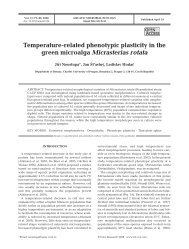
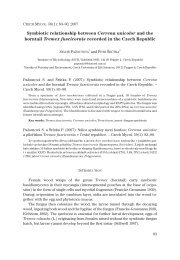
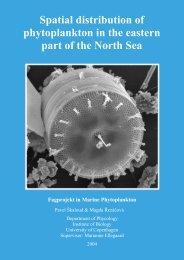
![[Cr(urea)6]Cl3](https://img.yumpu.com/47220263/1/184x260/crurea6cl3.jpg?quality=85)
